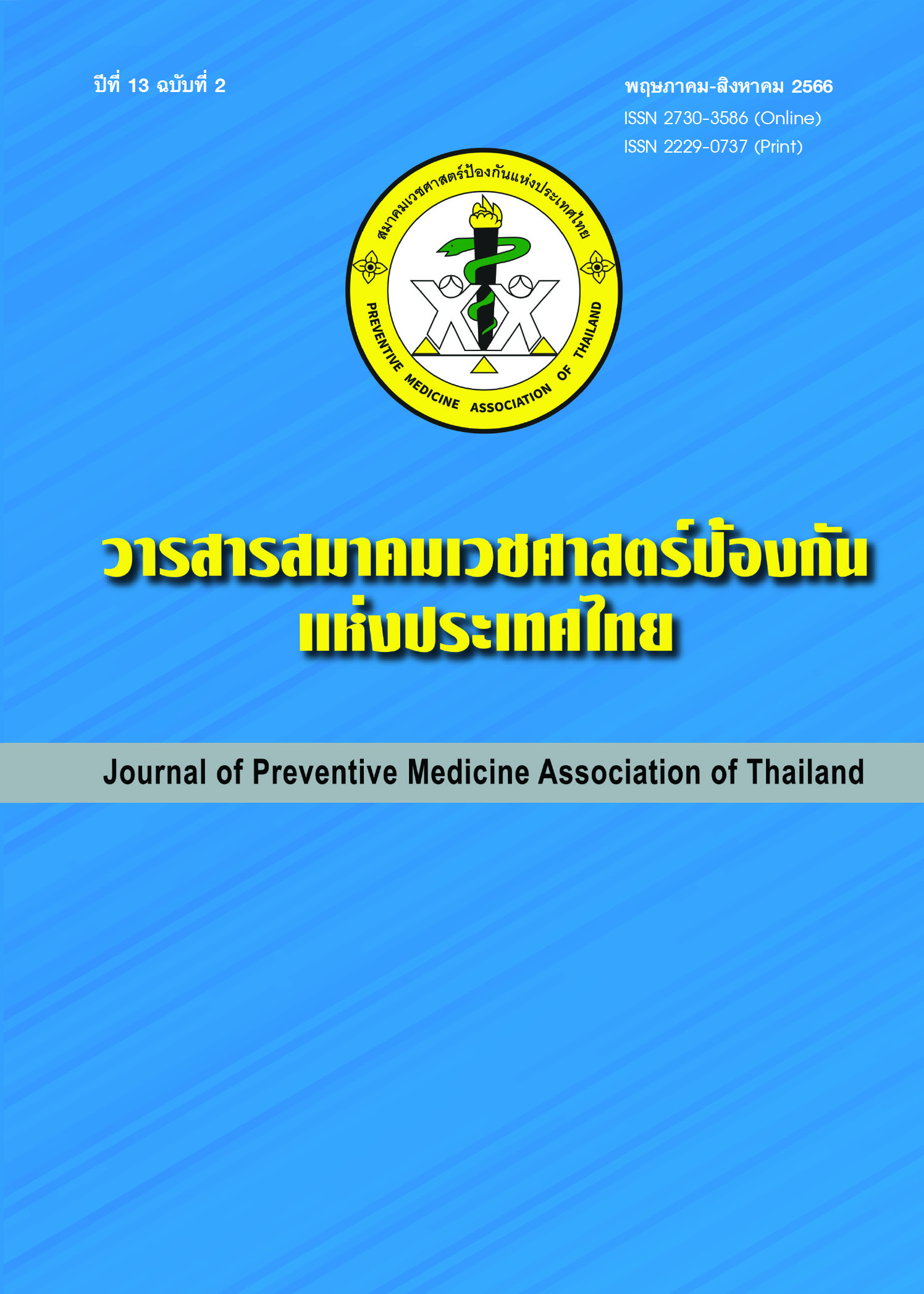Investigation of Salinity in Readily Prepared Foods at Naresuan University Canteens
Keywords:
sodium content per one serving, readily prepared foods, Naresuan University canteensAbstract
Objective: To survey the sodium content in foods from Naresuan University canteens. Materials and methods: This study was the cross-sectional descriptive study. 242 samples were collected twice in the same week, first time on Tuesday, and second time on Thursday. Data were recorded in the form, and salinity was measured by Salinity meter AZ8363. Mean, standard deviation and percentage were used to analyze the data. Results: The amount of sodium content per one serving were categorized into three groups: green group was less than 1,000 mg of sodium content per one serving, yellow group was 1,000-2,000 mg of sodium content per one serving, and red group was more than 2,000 mg of sodium content per one serving. From 94 samples of noodles (Clear Noodle Soup, Tom Yum Noodle and Nam Tok noodle); 2 samples (2.1%) were classified as green group [795±97.58 mg], 10 samples (10.6%) as yellow group [1,732±269.69 mg] and 82 samples (87.2%) as red group [3,377±760.09 mg]. From 124 samples of side dishes with rice (soup, stir-fried vegetable, curry with coconut milk, and Thai five spice pork and egg stew); 24 samples (19.4%) were classified as green group [705±173.31 mg], 66 samples (53.2%) as yellow group [1,469±262.54 mg], and 34 samples (27.4%) as red group [2,562±581.28 mg]. From 16 samples of spicy salad, 1 sample (6.2%) was classified as green group [988 mg], 7 samples (43.8%) as yellow group [1,200±143.03 mg] and 8 samples (50%) as red group [2,742±781.12 mg]. From 8 samples of Suki; 3 samples (37.5%) were classified as yellow group [1,449±270.01 mg] and 5 samples (62.5%) as red group [2,548±225.08 mg]. Conclusion: The yellow and red group were the samples that have 1,000 mg to more than 2,000 mg of sodium content per one serving. 100% of Suki samples, 97.8% of noodles samples, 93.8% of spicy salad samples, and 80.6% of side dishes with rice were classified as yellow and red group. Consuming 1-2 servings of readily prepared food at Naresuan University canteens may exceed the recommended daily sodium intake.
References
World Health Organization. Global target 4: a 30% relative reduction in mean population intake of salt/sodium. In: Mendis S, editor. Global Status Report on Noncommunicable Diseases 2014. Geneva: WHO Press; 2014. p.45-51.
กองโรคไม่ติดต่อ กรมควบคุมโรค. จำนวนและอัตราตายโรคไม่ติดต่อ ปี 2559 ถึง 2561 [อินเทอร์เน็ต]. 2562 [เข้าถึงเมื่อ 2 ก.ย. 2564] เข้าถึงได้จาก: http://www.thaincd.com/2016/mission/documents.php?tid=32&gid=1-020.
แผนงานวิจัยนโยบายอาหารและโภชนาการ เพื่อการสร้างเสริมสุขภาพ สำนักงานกองทุนสนับสนุนการสร้างเสริมสุขภาพ. ความจริงของโซเดียม ความจริงที่คุณและครอบครัวต้องรู้ [อินเทอร์เน็ต]. 2556 [เข้าถึงเมื่อ 2 ก.ย. 2564]. เข้าถึงได้จาก: http://fhpprogram.org/download/sodium/.
Adler AJ, Taylor F, Martin N, Gottlieb S, Taylor RS, Ebrahim S. Reduced dietary salt for the prevention of cardiovascular disease (Review). Cochrane Database Syst Rev 2014;12:1-13.
สิริมนต์ ชายเกตุ. ปัจจัยที่มีความสัมพันธ์กับโซเดียมจากอาหารที่บริโภคของนิสิตมหาวิทยาลัยศรีนครินทรวิโรฒ ประสานมิตร. วารสารหน่วยวิจัยวิทยาศาสตร์ เทคโนโลยีและสิ่งแวดล้อมเพื่อการเรียนรู้ 2559;7(1):103-14.
พัศมัย เอกก้านตรง, อุไรพร จิตต์แจ้ง, ประไพศรี ศิริจักรวาล, วันทนีย์ เกรียงสินยศ. ปริมาณโซเดียมในอาหารยอดนิยมภาคตะวันออกเฉียงเหนือของประเทศไทย. วารสารวิทยาลัยพยาบาลบรมราชชนนี นครราชสีมา 2561;24(2):6-17.
ปรัศนี ศรีกัน, สมศรี ทาทาน, วราภรณ์ ศรีจันทร์พาล, ชลธิมา ปิ่นสกุล. ความสัมพันธ์ระหว่างความรู้ ความสามารถในการดูแลตนเอง พฤติกรรมการลดการบริโภคอาหารที่มีโซเดียมสูง และปริมาณโซเดียมในปัสสาวะของนักศึกษาและบุคลากรของวิทยาลัยพยาบาลบรมราชชนนี พะเยา. วารสารวิทยาลัยพยาบาลบรมราชชนนี กรุงเทพ 2561;34(3):21-33.
สำนักโรคไม่ติดต่อ กรมควบคุมโรค. รายงานประจำปี 2558 [อินเทอร์เน็ต]. 2559 [เข้าถึงเมื่อ 30 ส.ค. 2564] เข้าถึงได้จาก: http://thaincd.com/document/file/download/paper-manual/Annual-report-2015.pdf.
Shin EK, Lee YK. Comparison of sodium content of workplace and homemade meals through chemical analysis and salinity measurements. Nutr Res Pract 2014;8(5):558-63.
วิชช์ เกษมทรัพย์, สุกฤตา พุ่มดวง. โครงการการทดสอบความแม่นยำของเครื่องตรวจปริมาณเกลือในตัวอย่างอาหารและปัสสาวะเพื่อประเมินการบริโภคเกลือในคนและการประยุกต์ใช้เพื่อช่วยลดการบริโภคเกลือในประชากร [อินเตอร์เน็ต]. 2560 [เข้าถึงเมื่อ 30 ส.ค. 2564] เข้าถึงได้จาก: http://www.lowsaltthai.com/uploads/6234/files/Research/โครงการการทดสอบความแม่นยำของเครื่องตรวจปริมาณเกลือในตัวอย่างอาหาร.pdf
เนตรนภัส วัฒนสุชาติ. การศึกษาปริมาณโซเดียมและโซเดียมคลอไรด์ในอาหารบาทวิถี (street foods) ที่จำหน่ายในเขตกรุงเทพมหานคร ประจำปี 2560 [อินเทอร์เน็ต]. 2560 [เข้าถึงเมื่อ 10 ม.ค. 2565]. เข้าถึงได้จาก: http://www.lowsaltthai.com/uploads/6234/files/Research/โครงการการศึกษาปริมาณโซเดียมและโซเดียมคลอไรด์ในอาหารบาทวิถี%20(Street%20foods).pdf
Downloads
Published
How to Cite
Issue
Section
License
Copyright (c) 2023 Journal of Preventive Medicine Association of Thailand

This work is licensed under a Creative Commons Attribution-NonCommercial-NoDerivatives 4.0 International License.
บทความที่ลงพิมพ์ในวารสารเวชศาสตร์ป้องกันแห่งประเทศไทย ถือเป็นผลงานวิชาการ งานวิจัย วิเคราะห์ วิจารณ์ เป็นความเห็นส่วนตัวของผู้นิพนธ์ กองบรรณาธิการไม่จำเป็นต้องเห็นด้วยเสมอไปและผู้นิพนธ์จะต้องรับผิดชอบต่อบทความของตนเอง






